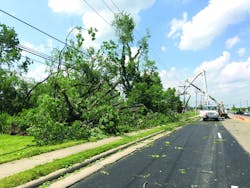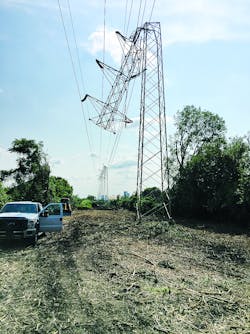Twisters Crumple Towers, Snap Poles in Ohio
Fifteen tornadoes folded transmission towers like tin cans, ripped out power poles from the ground, killed one person and knocked out power for 70,000 homes and businesses in Dayton, Ohio. In just a two-and-a-half hour period — from 10 p.m. on May 27 to 12:30 a.m. on May 28 — the twisters inflicted unforeseen destruction in Dayton Power & Light’s (DP&L’s) service territory.
Tornado-force winds destroyed more than 900 poles, some of which were not only snapped in half, but also picked up by the twisters and dropped on the land below. A significant amount of debris from the vegetation, broken power lines, cars and houses then wound up on a major highway, which needed to be cleared by a plow before restoration could even begin. In addition, the tornadoes blew 19 power poles on top of the nearby railway track, blocking the trains. Within one day, the line crews were able to remove and prepare to preset the poles so the railway could run once again.
Removing Debris
Back in 2012, DP&L was hit with straight-line winds from a derecho. Following that severe weather event, 200,000 were without power.
With the recent wrath of the tornadoes, however, DP&L had even more support and boots on the ground due to the sheer amount of damage. One of the twisters, upgraded to an EF4, was a half-mile wide, was on the ground for 19 miles and featured winds up to 200 mph. Also, 22 transmission lines, 345-kV lines, countless substations and 60 main-line circuits sustained significant damage from the tornadoes.
In the areas where this tornado touched down, it brought all of the debris with it, causing further damage. Before linemen could even access the damaged infrastructure, they had to first help to remove the debris, which was piled up across DP&L’s service territory.
“If we had to do a ranking of our most recent storms in a 15-year history from a customer outage standpoint, this would rank number seven, but as far as damage, it would be in the top three,” said Mary Ann Kabel, spokesperson for DP&L.
DP&L restored what it could, and the morning after the tornadoes hit, DP&L gathered all of its teams and sent its scouts out.
“In daylight, we could see what were were dealing with,” Kabel says. “On the first day, we made plans, started mobilizing crews and called for aid. At the peak, we had 1600 field and support personnel combined.”
Requesting Mutual Aid
To restore power and rebuild infrastructure swiftly and safely, DP&L requested mutual assistance. In response, utilities from across Ohio and from Indiana, Kentucky, Michigan, Pennsylvania, Tennessee and Virginia worked alongside DP&L to restore power to nearly all the customers who could safely receive electricity within just nine days.
Because many of these companies had helped DP&L just months before during a November ice storm, they were familiar with the utility’s system and safety procedures and protocols. To stay safe during the restoration, they were equipped with the proper personal protective equipment and mandated to participate in safety checks and job-site briefings.
With six to eight hours required to replace a pole and another three hours to replace a transformer, the linemen put in long hours to restore and replace the damaged infrastructure.
“With a rotation, crews were working around the clock,” Kabel said. “Our customers said they couldn’t go around the corner or street without seeing trucks.”
Rebuilding the System
To gain an aerial perspective of the damage, DP&L contracted with a helicopter services company to patrol and survey the damage. Compared to a ground inspection, this approach allowed DP&L’s engineering team and field crews to better assess the destruction, analyze data and formulate plans for rebuilding.
DP&L used helicopter services for its rebuilding effort. In early June, the utility replaced the crumpled transmission towers with new structures — all with a helicopter.
While DP&L’s service territory is in the path of “Tornado Alley,” the recent storm inflicted some of the most significant damage the city of Dayton, Ohio, has seen to date. By working with other mutual assistance crews and focusing on a safe and efficient restoration effort, Dayton and its surrounding communities are on their way to recovery.
To see a photo gallery, visit www.tdworld.com/electric-utility-operations.
Sidebar: Three Tips for Storm Response
- Turn communications on quickly and set clear expectations and then deliver on them. Before the tornadoes even hit, the media team was already on social media making the customers aware of the impending severe weather and tracking the movement of the utility crews. DP&L also posted updates on damage and power restoration on @DPLToday, its Twitter account.
- Provide community outreach. DP&L offered bags of ice to its affected customers and also set up charging stations for those who lost their homes and ability to power their devices and connect with their loved ones. In turn, the customers shared their stories with the DP&L employees and showed their gratitude to the linemen. For example, after her power was turned back on, one woman stayed up all night to make homemade tortillas for all the linemen who helped her.
- Train your teams. As part of their safety and training, linemen as well as other support personnel participate in Grid X, a scenario-based crisis communications exercise to uncover any gaps in storm restoration.

